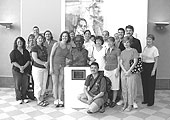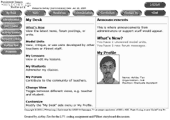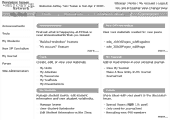
This section of my portfolio provides an overview of, and links to, descriptions of some development projects I have been involved in. |
|||||||||
| Navigation |
|||||||||
| [Overview] [Project 1] [Project 2] [Project 3] |
 With PIHnet Participants [+]
With PIHnet Participants [+] |
||||||||
| 1. Persistent Issues in History Network (PIHnet) | |||||||||
Context |
I have been with the PIHnet team since it began in Indiana University (IU) in 2002. I started as a volunteer and later became a research assistant. PIHnet provides highly customized training, resources, and tools for social studies and history teachers. Among the tools that were developed were a set of online lesson creating tools, administrative tools, a discussion forum, and a reflection journal. The lesson creating tools included a unit creator, activity creator, resource linker, scaffold editor/creator, and presenter. |
||||||||
| Conditions [Top] |
The IU PIHnet team worked with another team in Auburn University (AU) in Alabama. The AU team consists of the other principle investigator and his assistants. This team was responsible for the teacher training and content expertise. The IU team provided technical support and instructional design and development. Both teams conduct research based on teachers' use of PIHnet tools in their own classrooms. The teams relied on federal, university and private grants to fund projects and research efforts. Each grant cycle so far has been typically three years and as of 2005, PIHnet has a US$550,000 FIPSE grant as a main source of finance. This has allowed the IU team to hire a full-time computer programmer, video editors, and IST students as research assistants. The project started as a resource on the Civil Rights Movement and evolved to include basic online tools for creating lessons around this historical event. Now an entire curriculum for preservice and in-service teachers is built into and around PIHnet and the tools it offers is quite advanced. |
||||||||
| Roles [Top] |
In my capacity of research assistant, I have been involved in the design, development, implementation and evaluation of all PIHnet tools. However, my major role was creating prototypes for expert testing. Typically, I would work closely with one principle investigator to plan a conceptual prototype of a tool. I would then design a paper or rudimentary electronic prototype for testing. Eventually I would create a static Web version of the tool and then work with a programmer to create a dynamic or active version of tool online. As the tools moved out of development and into implementation, my role changed. I prepared instructions in the form of job aids for teachers and assisted them in a summer workshop. I collected and processed feedback from users, and then had to troubleshoot and/or redesign the tools. I also stepped into the role of Webmaster to maintain the public face of PIHnet. As PIHnet is password-protected, I created a tour of the tools and resources to allow guests examine what we had to offer. |
||||||||
| Contributions [Top] |
My contributions to PIHnet have been numerous and varied. However, I highlight two examples that drew on my areas of expertise: conceptual design, paper prototype design, prototype testing, and Web prototype design, development, evaluation and revision. 1. Journal tool The design of this tool was relevant to me. I was shaping my research agenda on teacher reflection and was contemplating the use of online journal entries as a source of data.
The design of this tool took place in three main phases:
2. My Desk page I designed a static prototype visual design as it was my usual role in the group to create prototypes creation and test them. I did this in the context of a project I was conducting in my minor course on Information Architecture.
In that course, I was required to create and usertest web page prototypes and the opportunity could not have been more timely. The usability testing of the prototype went smoothly and the computer programmer and one other instructional designer took over to create the current My Desk feature. My Desk currently serves as every PIHnet user's portal to PIHnet tools and resources. |
||||||||



